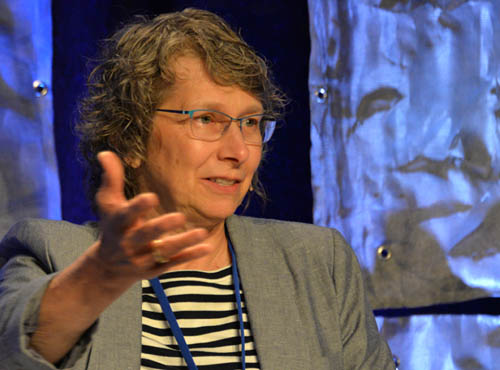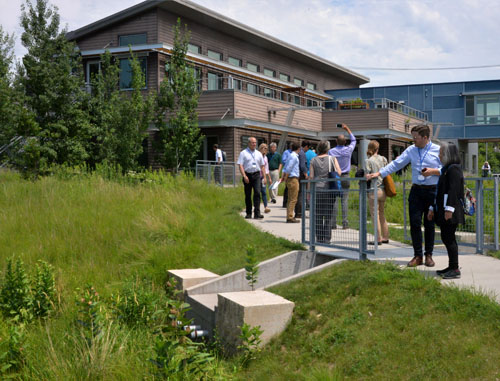Council collaborates with partners to ensure plentiful, clean water
Across America, water is facing serious challenges – from contamination and overuse to drought and flooding, as well as a growing population that jeopardizes plentiful, clean water for everyone.
This isn’t news to water advocates from all corners of life, who are already hard at work on solutions. Whether from science, industry, business, utilities, agriculture, government, nonprofits, or the public, people are working across sectors to find new solutions, and not relying on top-down, prescriptive remedies.
Solutions are not yet defined, but they are emerging. Some believe the key is to engage elected officials and residents through art and storytelling, with the goal of creating additional public awareness and action. Others know it’s critical to secure funding for innovative technological solutions to treat contaminated water.
These ideas and more were discussed at a major national water conference held July in Minneapolis. The Metropolitan Council was the local host to the U.S. Water Alliance’s “One Water Summit,” giving it an opportunity to share some of its own regional successes with national water experts.
Cross-sector and cross-cultural collaboration is key to addressing water issues
Council Chair Alene Tchourumoff welcomed the national audience of 900, saying that one of the key ingredients is collaboration. As leader of the regional body serving 188 communities and other local units of government, she knows the public is better served through the power of partnerships.
“The Met Council has been a strong partner for the Mississippi Watershed Management Organization in encouraging and supporting innovation in urban stormwater management, through collaboration in planning, capital projects and raising public awareness.”
- Doug Snyder, Executive Director
“After all the advances we’ve made to date, we are at a moment now where ‘business as usual’ doesn’t work anymore. We’re doing better now, and I’m glad to see that cross-sector and cross-cultural collaboration is starting to be valued more.
“In more recent years we can point to great local examples of environmental stewardship, livable communities, prosperity, and water sustainability. And with new waves of collaboration, integration and inclusion, we’ll do even better,” she said.
“We face great challenges but our capacity to work together to find innovative solutions is greater.”
Partnerships are key to achieving water sustainability
In many ways, the national One Water concept embodies regional strategies the Council has used for years: we all do better when we work together toward common goals.
“We know we can have a bigger impact in our work in water quality when we reach out and collaborate with our partners on specific projects benefiting local residents, and we’ve proven that time and again,” said Council Member Sandy Rummel, who chairs the Council's Environment Committee and spoke at the summit. “In fact, working with many partners across many disciplines delivers the best results and points the way to larger and more meaningful successes in the future.”
Six ‘Arenas for Action’ for sustainable water management
The theme of the Water Summit was clear: “One Water, One Future” – the notion that water is life, and we’re all in this together.
A cornerstone of the summit was encapsulated in the US Water Alliance’s “Six Arenas for Action.” Flexible and interdependent, the details of each goal provide concrete strategies that provide guideposts toward sustainable water:
-
Reliable and Resilient Water Utilities
-
Thriving Cities
-
Competitive Business and Industry
-
Sustainable Agriculture
-
Social and Economic Inclusion
-
Healthy Waterways
Not surprisingly, the strategies in each area dovetail with work that has been underway for many years by the Metropolitan Council and its Environmental Services Division.
 ES General Manager Leisa Thompson, who addressed the summit as a key panelist, has been instrumental in bringing a more holistic One Water approach to the Council for several years. Furthering One Water goals, she is leading the way toward stronger water partnerships that go back many decades.
ES General Manager Leisa Thompson, who addressed the summit as a key panelist, has been instrumental in bringing a more holistic One Water approach to the Council for several years. Furthering One Water goals, she is leading the way toward stronger water partnerships that go back many decades.
“For five decades we’ve used the model of interdependence to do our work treating wastewater within a partnership that now includes 110 communities across the seven-county region, and we now have a national-caliber system that proves we were on the right track,” Thompson said.
“As a regional agency that includes responsibility for metropolitan transit and community development, the Council has been able to leverage further successes over the past two decades not only in water quality but in other ways to help maintain a vital region that continues to attract new residents.
“There are regional challenges left to solve, of course. But we are optimistic that more collaborative approaches will become the norm, and that’s exactly the direction we are going,” Thompson said.
Council projects show results of national water sustainability goals
 The Council’s reputation for collaboration is among the reasons the One Water Summit came to Minneapolis. Over the three days of the event, the Council showed off several examples of projects that demonstrate powerful results from locally based collaborations.
The Council’s reputation for collaboration is among the reasons the One Water Summit came to Minneapolis. Over the three days of the event, the Council showed off several examples of projects that demonstrate powerful results from locally based collaborations.
-
Wastewater infrastructure improvements. For more than 10 years, the Metropolitan Council and regional communities have been working collaboratively to reduce clear water from entering the wastewater collection system. Even as the population has grown, wastewater flows have decreased due in large part to investments by the Council and regional communities.
-
Mercury pollution down 70% through partnership. Since 1993, a voluntary collaboration with the Minnesota Dental Association has reduced by 70% the amount of dental mercury amalgam reaching ES treatment plants and the region’s rivers.
-
Stormwater management grants pay dividends. The Council has provided $3.8 million in grants to metro communities since 2015 to help manage stormwater problems and fund innovative reuse and green infrastructure projects. Some examples of innovative projects were highlighted during the One Water Summit on a “Green Infrastructure Tour” of six sites across Minneapolis, built and maintained by the City of Minneapolis, Minneapolis Park and Recreation Board, Minneapolis Public Schools, and the Mississippi Watershed Management Organization.
-
Extensive monitoring program is key to improving surface water quality. The Council has developed an extensive water monitoring program that dates to 1976. Numerous public and nonprofit groups rely on the deep cache of data to assess problem areas and determine whether remediation efforts are working.
-
A newer challenge: long-range water supply planning. With a growing metro population and new threats to water supply, the Council has become a regional convener for long-range water supply planning. Since 2015, the Council has expanded participation in the 18-member Metro Area Water Advisory Committee by adding a 16-member technical advisory group that supports the committee as well as 7 sub-regional groups with dozens of member communities.
-
Innovative wastewater reuse projects are cutting edge. Working with key public and private partners, the Council in 2015 opened its first treatment plant now returning highly treated wastewater (known as “reclaimed water”) to shallow groundwater. Currently, a high-water use industry is seeking to build a new operation in the region that will use reclaimed water instead of clean water from the ground.
More information